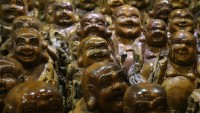Skull Fragment of the Buddha Discovered in China
| Arthur Dominic Villasanta | | Jul 01, 2016 10:47 PM EDT |
(Photo : Chinese Cultural Relics) Gold box in which the Buddha's skull bone was found
A Buddhist temple in Nanjing, China has yielded a parietal bone believed to be that of the sage Siddhartha Gautama Buddha who died either in 544 or 545 BCE.
Archaeologists said the bone was discovered inside a gold chest in a 1,000 year-old Buddhist meditation shrine beneath the Grand Bao'en Temple in Nanjing. Engravings say the skull belonged to Siddhartha Gautama.
Like Us on Facebook
When they opened the stone chest, archaeologists discovered an ornate shrine called a stupa. Inscriptions carved into the stone chest explain how Buddha's skull bone came to lie in the golden chest.
Stupas are mound-like structures containing relics, usually the remains of Buddhist monks or nuns. They are also used as places of meditation.
Archaeologists describe the box as 117 cm tall and 45 cm wide. The box is made from sandalwood and is encased in gold and silver on which jewels are embedded.
It is almost certain the skull fragment might be that of the Buddha who was cremated upon his death. There are, however, conflicting accounts as to the fate of the Buddha's cremated remains.
One account claims the Buddha was cremated at the Hirannavati River and his remains were divided into thousands of portions by the ruling king of the time. At least 19 of the Buddha's remains are believed to have found their way to China. One of these fragments is apparently the parietal bone in Nanjing.
Another account says Buddha's cremated remains were divided among eight royal families and his disciples. These remains were enshrined by the Indian emperor Ashoka into 84,000 stupas centuries later.
Buddhism originated in India and from here spread throughout much of Asia. There are an estimated 530 million Buddhists worldwide, making Buddhism one of the world's major religions.
TagsBuddha, Nanjing, Grand Bao'en Temple, Siddhartha Gautama Buddha
©2015 Chinatopix All rights reserved. Do not reproduce without permission
EDITOR'S PICKS
-

Did the Trump administration just announce plans for a trade war with ‘hostile’ China and Russia?
-

US Senate passes Taiwan travel bill slammed by China
-

As Yan Sihong’s family grieves, here are other Chinese students who went missing abroad. Some have never been found
-

Beijing blasts Western critics who ‘smear China’ with the term sharp power
-

China Envoy Seeks to Defuse Tensions With U.S. as a Trade War Brews
-

Singapore's Deputy PM Provides Bitcoin Vote of Confidence Amid China's Blanket Bans
-

China warns investors over risks in overseas virtual currency trading
-

Chinese government most trustworthy: survey
-

Kashima Antlers On Course For Back-To-Back Titles
MOST POPULAR
LATEST NEWS
Zhou Yongkang: China's Former Security Chief Sentenced to Life in Prison

China's former Chief of the Ministry of Public Security, Zhou Yongkang, has been given a life sentence after he was found guilty of abusing his office, bribery and deliberately ... Full Article
TRENDING STORY

China Pork Prices Expected to Stabilize As The Supplies Recover

Elephone P9000 Smartphone is now on Sale on Amazon India

There's a Big Chance Cliffhangers Won't Still Be Resolved When Grey's Anatomy Season 13 Returns

Supreme Court Ruled on Samsung vs Apple Dispute for Patent Infringement

Microsoft Surface Pro 5 Rumors and Release Date: What is the Latest?













